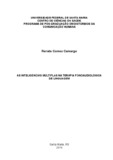| dc.creator | Camargo, Renata Gomes | |
| dc.date.accessioned | 2017-10-17T12:50:53Z | |
| dc.date.available | 2017-10-17T12:50:53Z | |
| dc.date.issued | 2016 | |
| dc.identifier.uri | http://repositorio.ufsm.br/handle/1/11870 | |
| dc.description.abstract | The strategies and resources used in speech-language therapy are conducted based on previously objectives and in accordance with patients’ language disorders characteristics. These speech-language strategies and resources can be conducted from the different intelligences frameworks that are established during interventions. In this sense, the present thesis investigates a protocol of speech-language therapy based on the Theory of Multiple Intelligences, in which eight types of intelligences appears as structure of human intellect such as: linguistic, logical-mathematical, kinesthetic-corporal, spatial, musical, naturalistic, interpersonal and intrapersonal. The present work aimed to investigate the access of the multiple intelligences through speech-language therapy in order to develop verbal language (linguistic intelligence). The investigation was followed by a quantitative and qualitative approach. Analysis of content and statistical tests were used to verify the influences of multiple intelligences on the outcomes of the therapies. The sample consisted of 107 patients with language disorders and 62 therapists. Patients were attended at the Speech and Hearing Service of Federal University of Santa Maria. Regarding the characteristics of the patients and the therapists, as well as, the variety of resources and strategies utilized during interventions, it was observed that the discrimination and integration of the eight multiple intelligences in the speech-language therapy has significant implication on levels of linguistic complexity worked and developing communication the patients’. | eng |
| dc.language | por | por |
| dc.publisher | Universidade Federal de Santa Maria | por |
| dc.rights | Attribution-NonCommercial-NoDerivatives 4.0 International | * |
| dc.rights.uri | http://creativecommons.org/licenses/by-nc-nd/4.0/ | * |
| dc.subject | Terapia da linguagem | por |
| dc.subject | Fonoterapia | por |
| dc.subject | Inteligências múltiplas | por |
| dc.subject | Fonoaudiologia | por |
| dc.subject | Language therapy | eng |
| dc.subject | Speech therapy | eng |
| dc.subject | Multiple intelligences | eng |
| dc.subject | Speech | eng |
| dc.subject | Language and hearing sciences | eng |
| dc.title | As inteligências múltiplas na terapia fonoaudiológica de linguagem | por |
| dc.title.alternative | The multiple intelligences in the language therapy | eng |
| dc.type | Tese | por |
| dc.description.resumo | As estratégias e os recursos utilizados na terapia fonoaudiológica são selecionados a partir das características dos pacientes com alteração de linguagem verbal e dos objetivos estabelecidos para o atendimento. Esta seleção e a aplicação dos mesmos podem ser visualizadas a partir da(s) diferente(s) inteligência(s) que é (são) contemplada(s) nas atividades desenvolvidas. Neste sentido, esta tese versa sobre o estudo da terapia fonoaudiológica de linguagem com base na Teoria das Inteligências Múltiplas, na qual são apresentados oito tipos de inteligências que estão estruturadas no intelecto humano, a saber: linguística, lógico-matemática, cinestésico-corporal, espacial, musical, naturalista, interpessoal e intrapessoal. A investigação teve por objetivo geral investigar a contemplação das oito inteligências na terapia fonoaudiológica sob o ponto de vista do favorecimento do desenvolvimento da linguagem verbal (da inteligência linguística). Seguiu-se a abordagem quanti-qualitativa da pesquisa, com análise de conteúdo e aplicação de testes estatísticos, para verificar a interferência desta contemplação sob os resultados das terapias. A amostra foi composta por 107 pacientes com alteração de linguagem e 62 terapeutas, os quais frequentavam e atuavam, respectivamente, no Serviço de Atendimento Fonoaudiológico, da Universidade Federal de Santa Maria. Com o estudo desenvolvido nesta tese evidenciou-se que a diferenciação da contemplação das oito inteligências na terapia de linguagem, investigada em relação às características dos pacientes e dos terapeutas e à variedade de recursos e estratégias, tem implicações sobre os resultados obtidos, referentes às habilidades e níveis de complexidade linguística e aos meios de comunicação. | por |
| dc.contributor.advisor1 | Mezzomo, Carolina Lisbôa | |
| dc.contributor.advisor1Lattes | http://lattes.cnpq.br/3084638267716841 | por |
| dc.contributor.referee1 | Brandão, Ana Paula Barros | |
| dc.contributor.referee1Lattes | http://lattes.cnpq.br/5565558385115699 | por |
| dc.contributor.referee2 | Vidor, Deisi Cristina Gollo Marques | |
| dc.contributor.referee2Lattes | http://lattes.cnpq.br/3577015792465355 | por |
| dc.contributor.referee3 | Souza, Ana Paula Ramos de | |
| dc.contributor.referee3Lattes | http://lattes.cnpq.br/7859963389320763 | por |
| dc.contributor.referee4 | Freitas, Soraia Napoleão | |
| dc.contributor.referee4Lattes | http://lattes.cnpq.br/8605918251808106 | por |
| dc.creator.Lattes | http://lattes.cnpq.br/4985515546101901 | por |
| dc.publisher.country | Brasil | por |
| dc.publisher.department | Fonoaudiologia | por |
| dc.publisher.initials | UFSM | por |
| dc.publisher.program | Programa de Pós-Graduação em Distúrbios da Comunicação Humana | por |
| dc.subject.cnpq | CNPQ::CIENCIAS DA SAUDE::FONOAUDIOLOGIA | por |
| dc.publisher.unidade | Centro de Ciências da Saúde | por |



